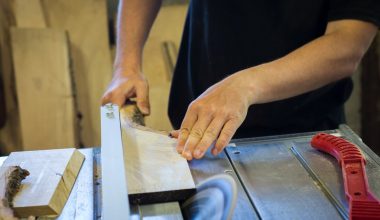We love our home interiors and always looking for ways to make them feel more homely. Finishing off a room with crown molding can really help bring together the full effect you are looking for.
Molding is a type of trim that is used inside a house to finish off a room and around door frames. Crown molding is specifically between the walls and the ceiling as it is at the top of the room much like a crown is at the top of your head. Traditionally crown moldings were used to cover up gaps and poor joints along the edges of the walls. However, these days they are purely decorative.
What tool to use to cut crown molding
The best tool for cutting crown molding is a miter saw. This is because we will be cutting miter cuts to create the perfect corners. A miter saw allows you to quickly change the angle from 0 to 45 degrees. Depending on your saw you may be able to change the angel both left and right.
A powered miter saw is much more efficient and accurate compared to using a manual miter box. Often crown molding isn’t very wide so a sliding miter saw isn’t essential. However, good positioning of the table and blade rotation is important.
Measure twice cut once
After you have chosen your crown molding design it is time to measure up your room. Measure the distance between each wall, taking note of all the lengths. We find that it helps to draw a box on a piece of paper and label each wall respectively. An angle finder is a great tool to check the angle of your corner before any corner cuts.
The more accurately you make your measurements the better the fit will be on installation. It is also worth checking that your walls are flat. If you have an older house they may be bowed which can make fitting molding very difficult.
Setting up your miter saw for cutting crown molding
There are to different ways that a compound miter saw can be used to cut crown molding corner joints. These are the vertically nested method and the flat method. Each method has its pros and cons so we will talk you through them both.
Inside corners
Setting up for a vertically nested inside corner cut is relatively straight forward. We suggest adding some tape onto your table to remind you that this is where the top of the molding should be. A good way to remember this is “top equals table” as we cut the molding upside down. Next check that your saw can freely rotate its table 45 degrees in either direction. Before cutting make sure to use a scrap piece to test on first.
Now with the top of your molding resting on the table and the bottom against your fence you are ready to cut. Make your first 45 degree cut with the table rotated 45 degrees to the left. Now rotate the table 45 degrees to the right, placing your next piece of molding on the right side of the saw and make your cut.
To set up for a flat inside corner cut we need to make sure our angles are exact for our corner to meet perfectly. The benefits of using a flat cut are that your material is more secure. For longer or heavier material, you don’t need to worry about clamping it upside down which will take time.
Outside corners
When going adding trim to a more complex room you will find the need to go around outside corners. These are more complicated as two edges are less likely to be exactly square so a standard 45-degree cut won’t work.
We are more likely to use the vertically nested technique for this as it’s easier to think about the angles when they are changing. Remember that your molding will now be on the opposite side to the blade compared to an inside corner. To help make sure your angles are correct use an angle finder and a crown molding calculator to work out your cutting angles.
Long room sections
When adding molding to a room that has walls longer than a standard piece of molding you need to do a special cut. A scarf joint is created by joining two complementary 45-degree angles. This helps to hide the joint and can be easily filled with a wood filler or cork to patch it up.






